RealWaste: A Novel Real-Life Data Set for Landfill Waste Classification Using Deep Learning
Abstract
:1. Introduction
- We created the first dataset, RealWaste, to comprehensively cover more classes of landfilled waste required for sustainable waste management. It includes three primary material types for divertible organics, recyclable inorganics, and waste, with meticulously refined labels for food, vegetation, metal, glass, plastic, paper, cardboard, textile trash, and miscellaneous trash. There are 4808 samples captured with the resolution of 524 × 524 from the Whyte’s Gully Waste and Resource Recovery Centre’s landfill site located in Wollongong, New South Wales, Australia, where waste items from municipal waste collection comingle and contaminate one another.
- The evaluation and analysis of five deep learning models over the RealWaste dataset and the datasets existing in the literature. The selection of models used has been intentionally made broad with respect to their design motivations to draw generalised outcomes on the larger input image resolution. Moreover, our objective is to evaluate the performance of the model when type of material over different items is important to be detected. The outcome shows that waste detection is indeed achievable for the meticulously refined classes required in sustainable waste management, with every model reaching above 85% classification accuracy, with the best performer at 89.19%.
2. Related Work
3. Methodology
3.1. Data Preprocessing
3.1.1. Image Size
3.1.2. Data Augmentation
3.2. Model Training
Hyperparameter Specification
4. DiversionNet versus RealWaste
4.1. Model Training
4.2. Testing Performance
4.3. Analysis
5. Conclusions
Author Contributions
Funding
Data Availability Statement
Acknowledgments
Conflicts of Interest
References
- Hoornweg, D.; Bhada-Tata, P. What a waste: A global review of solid waste management. Urban Dev. Ser. Knowl. Pap. 2012, 15, 87–88. [Google Scholar]
- Öman, C.B.; Junestedt, C. Chemical characterization of landfill leachates—400 parameters and compounds. Waste Manag. 2008, 28, 1876–1891. [Google Scholar] [CrossRef]
- Themelis, N.J.; Ulloa, P.A. Methane generation in landfills. Renew. Energy 2006, 32, 1243–1257. [Google Scholar] [CrossRef]
- Goverment, A. National Greenhouse and Energy Reporting Regulations 2008. 2008. Available online: https://www.legislation.gov.au/Details/F2020C00673 (accessed on 1 January 2020).
- Climate Watch Historical GHG Emissions (1990–2020); World Resources Institute: Washington, DC, USA. Available online: https://www.climatewatchdata.org/ghg-emissions (accessed on 1 January 2020).
- United Nations Environment Programme and Climate and Clean Air Coalition. Global Methane Assessment: Benefits and Costs of Mitigating Methane Emissions; United Nations Environment Programme: Nairobi, Kenya, 2021. [Google Scholar]
- El-Fadel, M.; Bou-Zeid, E.; Chahine, W.; Alayli, B. Temporal variation of leachate quality from pre-sorted and baled municipal solid waste with high organic and moisture content. Waste Manag. 2002, 22, 269–282. [Google Scholar] [CrossRef] [PubMed]
- Karanjekar, R.V.; Bhatt, A.; Altouqui, S.; Jangikhatoonabad, N.; Durai, V.; Sattler, M.L.; Hossain, M.S.; Chen, V. Estimating methane emissions from landfills based on rainfall, ambient temperature, and waste composition: The CLEEN model. Waste Manag. 2015, 46, 389–398. [Google Scholar] [CrossRef] [PubMed]
- Cruz, F.B.D.L.; Barlaz, M.A. Estimation of Waste Component-Specific Landfill Decay Rates Using Laboratory-Scale Decomposition Data. Environ. Sci. Technol. 2016, 44, 4722–4728. [Google Scholar] [CrossRef] [PubMed]
- Lee, U.; Han, J.; Wang, M. Evaluation of landfill gas emissions from municipal solid waste landfills for the life-cycle analysis of waste-to-energy pathways. J. Clean. Prod. 2017, 166, 335–342. [Google Scholar] [CrossRef]
- Kamran, A.; Chaudhry, M.N.; Batool, S.A. Effects of socio-economic status and seasonal variation on municipal solid waste composition: A baseline study for future planning and development. Environ. Sci. Eur. 2015, 27, 16. [Google Scholar] [CrossRef]
- Khan, F.; Ahmed, W.; Najmi, A. Understanding consumers’ behavior intentions towards dealing with the plastic waste: Perspective of a developing country. Resour. Conserv. Recycl. 2019, 142, 49–58. [Google Scholar] [CrossRef]
- Parizeau, K.; von Massow, M.; Martin, R. Household-level dynamics of food waste production and related beliefs, attitudes, and behaviours in Guelph, Ontario. Waste Manag. 2015, 35, 207–217. [Google Scholar] [CrossRef]
- Melinte, D.O.; Travediu, A.-M.; Dumitriu, D.N. Deep Convolutional Neural Networks Object Detector for Real-Time Waste Identification. Appl. Sci. 2020, 10, 7301. [Google Scholar] [CrossRef]
- Zhang, Q.; Zhang, X.; Mu, X.; Wang, Z.; Tian, R.; Wang, X.; Liu, X. Recyclable waste image recognition based on deep learning. Resour. Conserv. Recycl. 2021, 171, 105636. [Google Scholar] [CrossRef]
- Mao, W.-L.; Chen, W.-C.; Wang, C.-T.; Lin, Y.-H. Recycling waste classification using optimized convolutional neural network. Resour. Conserv. Recycl. 2021, 164, 105132. [Google Scholar] [CrossRef]
- Aral, R.A.; Keskin, Ş.R.; Kaya, M.; Hacıömeroğlu, M. Classification of TrashNet Dataset Based on Deep Learning Models. In Proceedings of the 2018 IEEE International Conference on Big Data (Big Data), Seattle, WA, USA, 10–13 December 2018; pp. 2058–2062. [Google Scholar] [CrossRef]
- Liang, S.; Gu, Y. A deep convolutional neural network to simultaneously localize and recognize waste types in images. Waste Manag. 2021, 126, 247–257. [Google Scholar] [CrossRef] [PubMed]
- Funch, O.I.; Marhaug, R.; Kohtala, S.; Steinert, M. Detecting glass and metal in consumer trash bags during waste collection using convolutional neural networks. Waste Manag. 2021, 119, 30–38. [Google Scholar] [CrossRef] [PubMed]
- Russakovsky, O.; Deng, J.; Su, H.; Krause, J.; Satheesh, S.; Ma, S.; Huang, Z.; Karpathy, A.; Khosla, A.; Bernstein, M.; et al. ImageNet Large Scale Visual Recognition Challenge. Int. J. Comput. Vis. 2015, 115, 211–252. [Google Scholar] [CrossRef]
- He, X.; Chen, Y.; Ghamisi, P. Heterogeneous Transfer Learning for Hyperspectral Image Classification Based on Convolutional Neural Network. IEEE Trans. Geosci. Remote Sens. 2020, 58, 3246–3263. [Google Scholar] [CrossRef]
- Basha, S.H.S.; Dubey, S.R.; Pulabaigari, V.; Mukherjee, S. Impact of fully connected layers on performance of convolutional neural networks for image classification. Neurocomputing 2020, 378, 112–119. [Google Scholar] [CrossRef]
- Sharma, N.; Jain, V.; Mishra, A. An Analysis Of Convolutional Neural Networks For Image Classification. Procedia Comput. Sci. 2018, 132, 377–384. [Google Scholar] [CrossRef]
- Shijie, J.; Ping, W.; Peiyi, J.; Siping, H. Research on data augmentation for image classification based on convolution neural networks. In Proceedings of the 2017 Chinese Automation Congress (CAC), Jinan, China, 20–22 October 2017; pp. 4165–4170. [Google Scholar] [CrossRef]
- Zhang, C.; Zhou, P.; Li, C.; Liu, L. A Convolutional Neural Network for Leaves Recognition Using Data Augmentation. In Proceedings of the 2015 IEEE International Conference on Computer and Information Technology; Ubiquitous Computing and Communications; Dependable, Autonomic and Secure Computing; Pervasive Intelligence and Computing, Liverpool, UK, 26–28 October 2015; pp. 2143–2150. [Google Scholar] [CrossRef]
- de la Rosa, F.L.; Gómez-Sirvent, J.L.; Sánchez-Reolid, R.; Morales, R.; Fernández-Caballero, A. Geometric transformation-based data augmentation on defect classification of segmented images of semiconductor materials using a ResNet50 convolutional neural network. Expert Syst. Appl. 2022, 206, 117731. [Google Scholar] [CrossRef]
- Sabottke, C.F.; Spieler, B.M. The Effect of Image Resolution on Deep Learning in Radiography. Radiol. Artif. Intell. 2020, 2, e190015. [Google Scholar] [CrossRef] [PubMed]
- Krizhevsky, A.; Sutskever, I.; Hinton, G.E. ImageNet classification with deep convolutional neural networks. Commun. ACM 2012, 60, 84–90. [Google Scholar] [CrossRef]
- Simonyan, K.; Zisserman, A. Very Deep Convolutional Networks for Large-Scale Image Recognition. arXiv 2014, arXiv:1409.1556. [Google Scholar] [CrossRef]
- Szegedy, C.; Liu, W.; Jia, Y.; Sermanet, P.; Reed, S.; Anguelov, D.; Erhan, D.; Vanhoucke, V.; Rabinovich, A. Going deeper with convolutions. In Proceedings of the 2015 IEEE Conference on Computer Vision and Pattern Recognition (CVPR), Boston, MA, USA, 12 June 2015; pp. 1–9. [Google Scholar] [CrossRef]
- He, K.; Zhang, X.; Ren, S.; Sun, J. Deep Residual Learning for Image Recognition. arXiv 2015, arXiv:1512.03385. [Google Scholar] [CrossRef]
- Huang, G.; Liu, Z.; Maaten, L.V.D.; Weinberger, K.Q. Densely Connected Convolutional Networks. In Proceedings of the 2017 IEEE Conference on Computer Vision and Pattern Recognition (CVPR), Honolulu, HI, USA, 21–26 July 2017; pp. 2261–2269. [Google Scholar] [CrossRef]
- Szegedy, C.; Ioffe, S.; Vanhoucke, V.; Alemi, A.A. Inception-v4, inception-ResNet and the impact of residual connections on learning. In Proceedings of the Thirty-First AAAI Conference on Artificial Intelligence, San Francisco, CA, USA, 12 February 2017. [Google Scholar]
- Sandler, M.; Howard, A.; Zhu, M.; Zhmoginov, A.; Chen, L.C. MobileNetV2: Inverted Residuals and Linear Bottlenecks. In Proceedings of the 2018 IEEE/CVF Conference on Computer Vision and Pattern Recognition, Salt Lake City, UT, USA, 18–23 June 2018; pp. 4510–4520. [Google Scholar] [CrossRef]
- Yang, M.; Thung, G. TrashNet, Github. 2016. Available online: https://github.com/garythung/trashnet (accessed on 20 November 2023).
- Yu, C.; Wang, F.; Shao, Z.; Sun, T.; Wu, L.; Xu, Y. DSformer: A Double Sampling Transformer for Multivariate Time Series Long-term Prediction. In Proceedings of the 32nd ACM International Conference on Information and Knowledge Management, Birmingham, UK, 21–25 October 2023. [Google Scholar] [CrossRef]
- Dosovitskiy, A.; Beyer, L.; Kolesnikov, A.; Weissenborn, D.; Zhai, X.; Unterthiner, T.; Dehghani, M.; Minderer, M.; Heigold, G.; Gelly, S.; et al. An Image is Worth 16x16 Words: Transformers for Image Recognition at Scale. arXiv 2020, arXiv:2010.11929. [Google Scholar]
- Dong, Z.; Chen, J.; Lu, W. Computer vision to recognize construction waste compositions: A novel boundary-aware transformer (BAT) model. J. Environ. Manag. 2022, 305, 114405. [Google Scholar] [CrossRef]
- Single, S.; Iranmanesh, S.; Raad, R. RealWaste, Electronic Dataset, Wollongong City Council, CC BY-NC-SA 4.0. Available online: https://github.com/sam-single/realwaste (accessed on 20 November 2023).
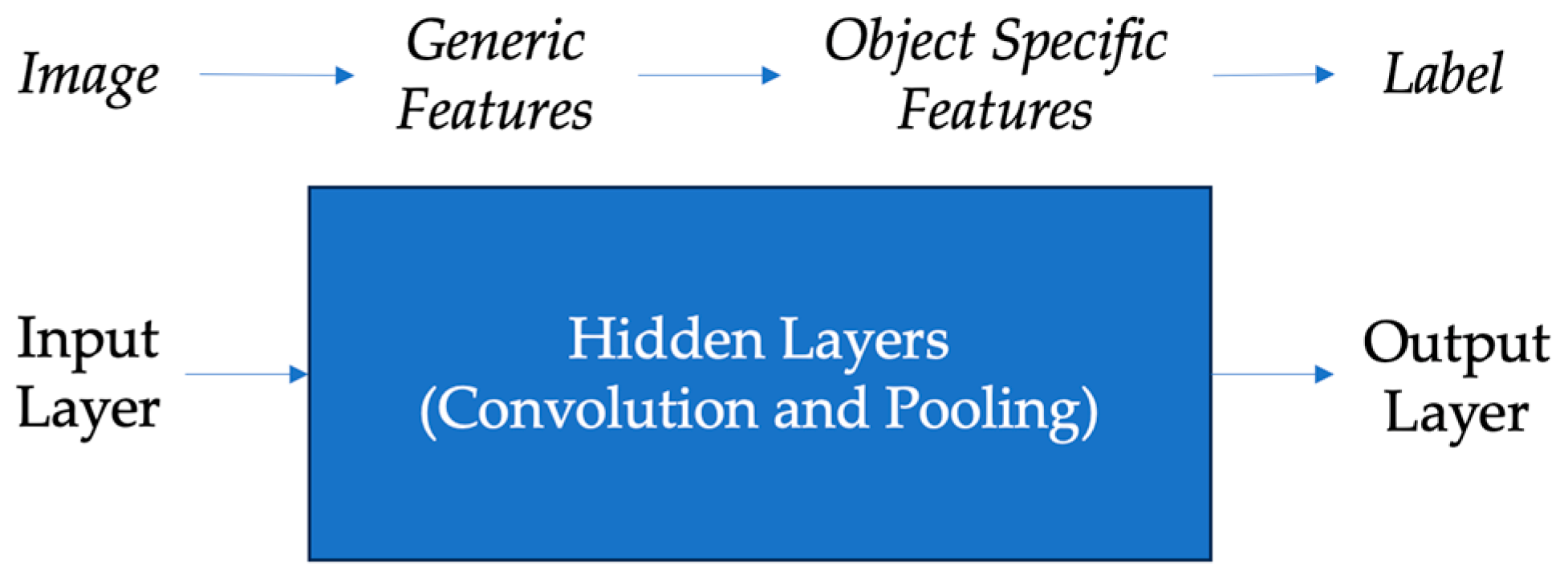
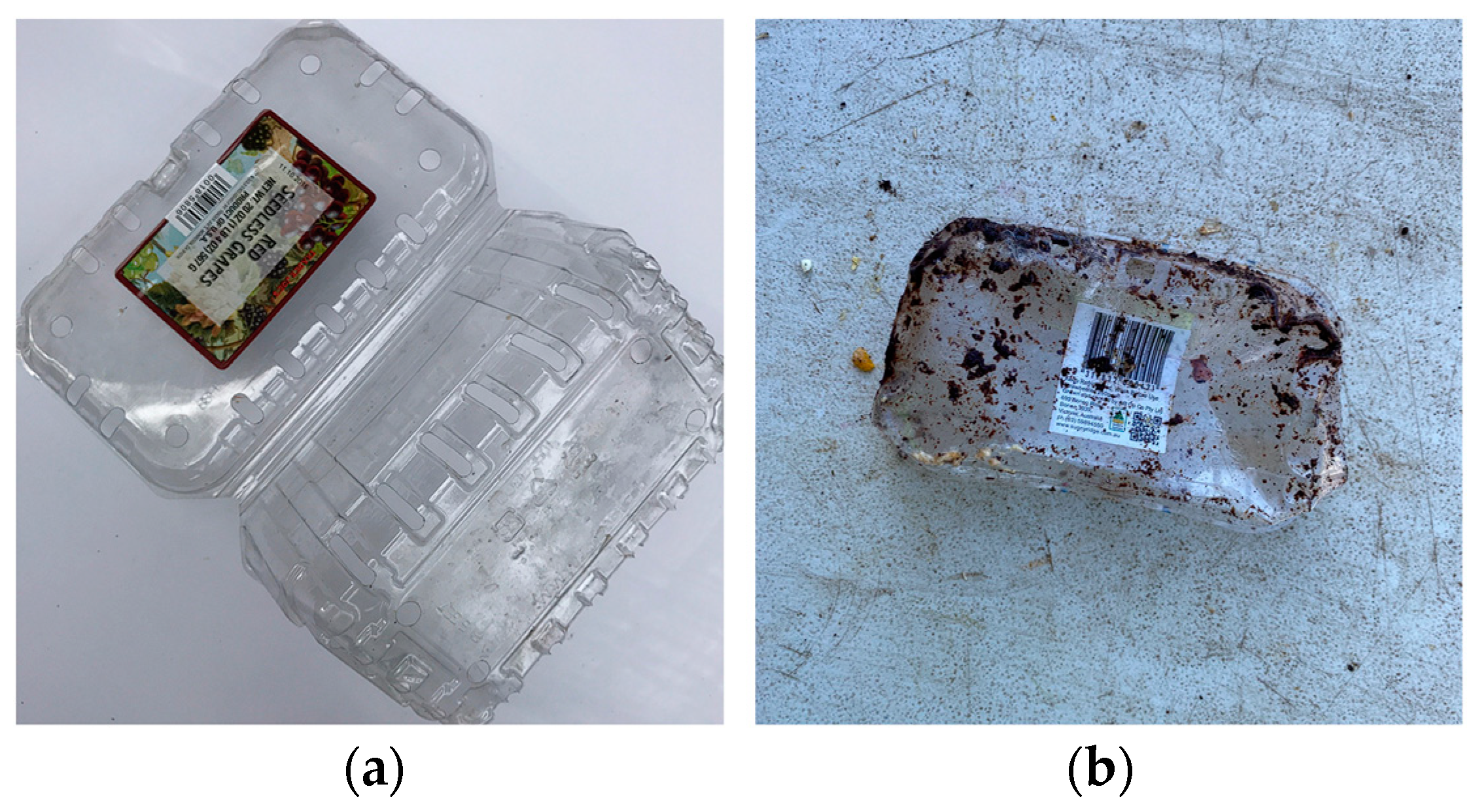
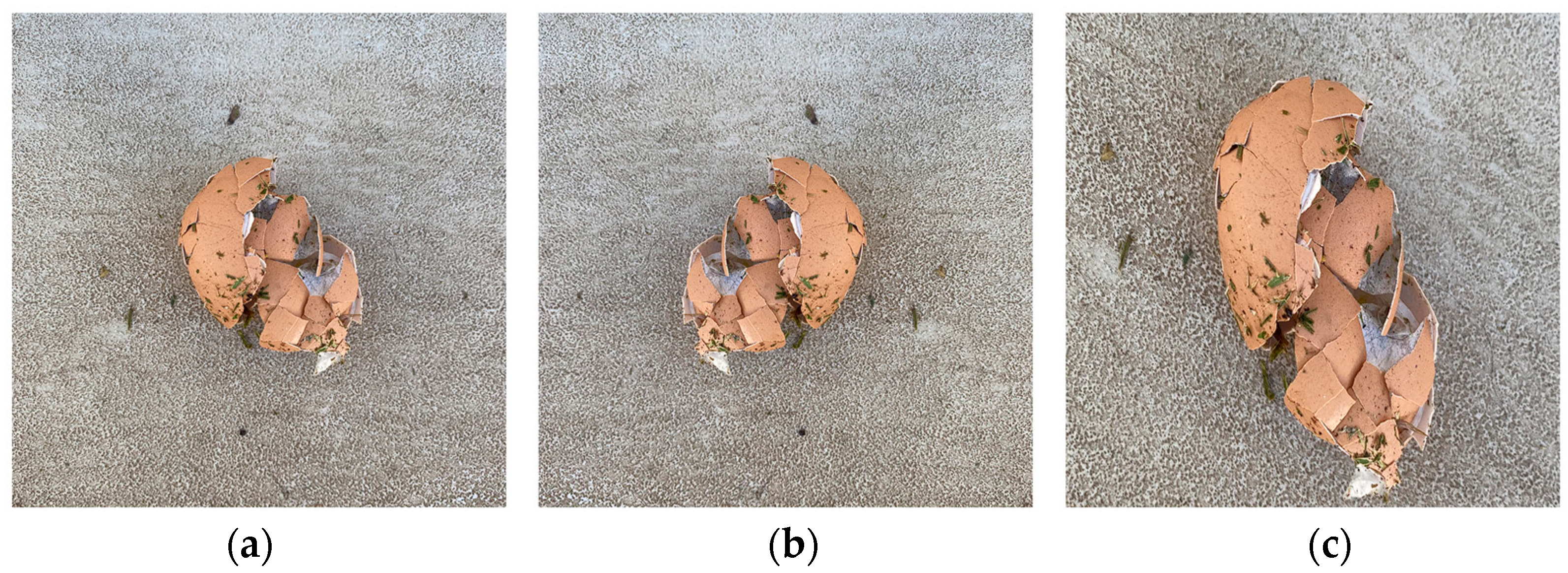


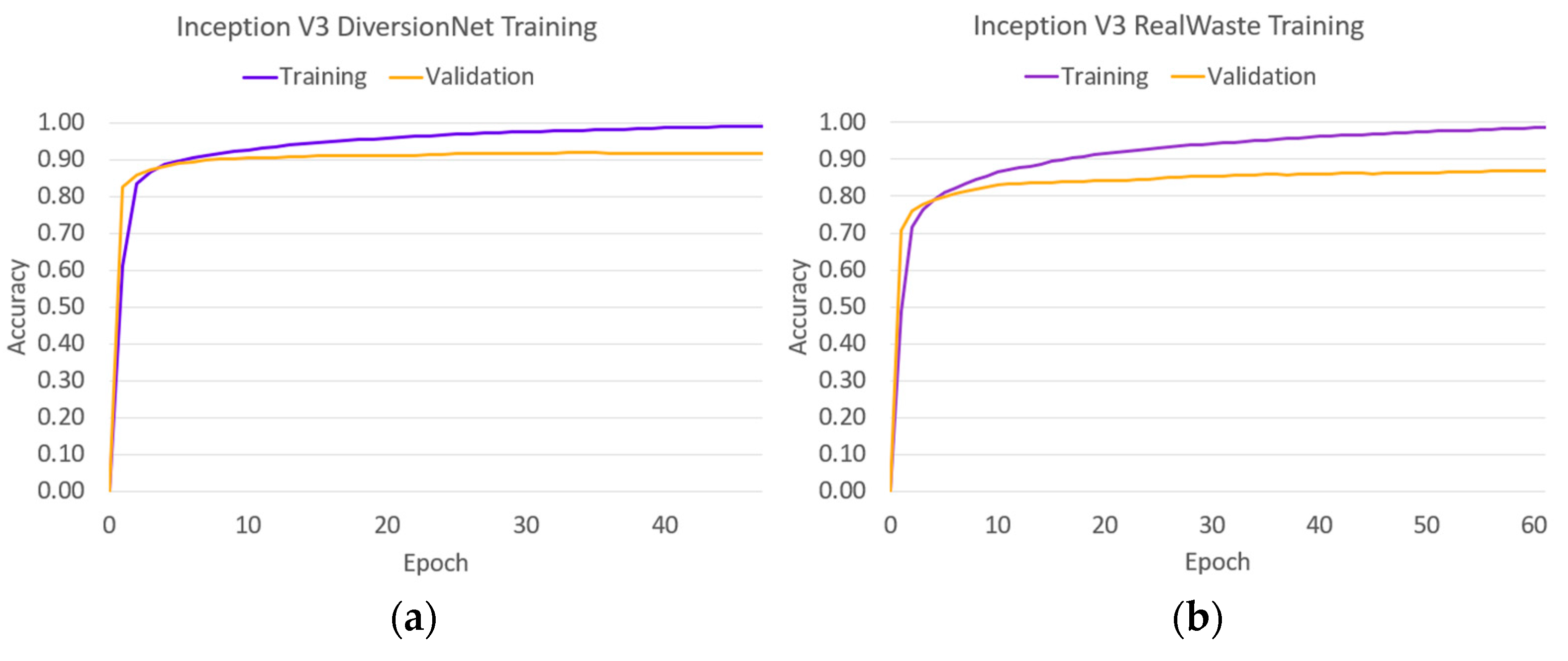



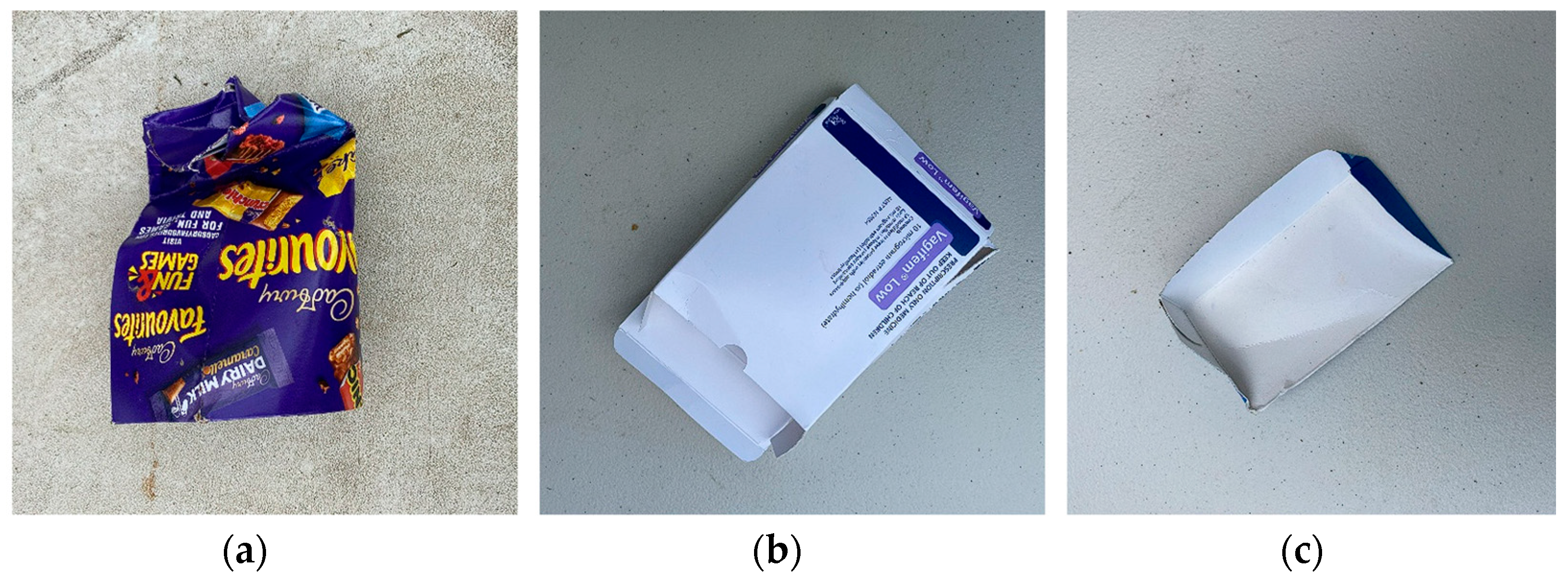



| Label | DiversionNet | RealWaste | Test |
|---|---|---|---|
| Cardboard | 403 | 417 | 46 |
| Food Organics | 311 | 370 | 41 |
| Glass | 501 | 378 | 42 |
| Metal | 410 | 711 | 79 |
| Miscellaneous Trash | 290 | 445 | 50 |
| Paper | 594 | 497 | 55 |
| Plastic | 482 | 831 | 92 |
| Textile Trash | 417 | 286 | 32 |
| Vegetation | 519 | 392 | 44 |
| Set No. | Augmentation Techniques |
|---|---|
| 1 | Horizontal flip and elastic distortion |
| 2 | Rotate and shear |
| Model | Batch Size | Learning Rate for Fully Connected Layers | Learning Rate for Feature Extraction Layers |
|---|---|---|---|
| VGG-16 | 4 | 1 × 10−5 | 1 × 10−5 |
| DenseNet121 | 16 | 1 × 10−4 | 1 × 10−5 |
| Inception V3 | 32 | 1 × 10−5 | 1 × 10−5 |
| InceptionResNet V2 | 32 | 1 × 10−6 | 1 × 10−6 |
| MobileNetV2 | 4 | 1 × 10−5 | 1 × 10−5 |
| Model | Accuracy | Precision | Recall | F1-Score |
|---|---|---|---|---|
| DiversionNet Training | ||||
| VGG-16 | 26.82% | 28.80% | 25.99% | 27.32% |
| DenseNet121 | 40.33% | 44.80% | 34.93% | 39.25% |
| Inception V3 | 49.69% | 55.43% | 39.29% | 45.98% |
| InceptionResNet V2 | 44.70% | 52.83% | 40.75% | 46.01% |
| MobileNetV2 | 27.65% | 28.50% | 24.95% | 26.61% |
| RealWaste Training | ||||
| VGG-16 | 85.65% | 87.74% | 84.82% | 86.26% |
| DenseNet121 | 89.19% | 90.06% | 86.69% | 89.62% |
| Inception V3 | 89.19% | 91.34% | 87.73% | 90.25% |
| InceptionResNet V2 | 87.32% | 89.69% | 85.03% | 88.49% |
| MobileNetV2 | 88.15% | 89.98% | 85.86% | 87.87% |
Disclaimer/Publisher’s Note: The statements, opinions and data contained in all publications are solely those of the individual author(s) and contributor(s) and not of MDPI and/or the editor(s). MDPI and/or the editor(s) disclaim responsibility for any injury to people or property resulting from any ideas, methods, instructions or products referred to in the content. |
© 2023 by the authors. Licensee MDPI, Basel, Switzerland. This article is an open access article distributed under the terms and conditions of the Creative Commons Attribution (CC BY) license (https://creativecommons.org/licenses/by/4.0/).
Share and Cite
Single, S.; Iranmanesh, S.; Raad, R. RealWaste: A Novel Real-Life Data Set for Landfill Waste Classification Using Deep Learning. Information 2023, 14, 633. https://doi.org/10.3390/info14120633
Single S, Iranmanesh S, Raad R. RealWaste: A Novel Real-Life Data Set for Landfill Waste Classification Using Deep Learning. Information. 2023; 14(12):633. https://doi.org/10.3390/info14120633
Chicago/Turabian StyleSingle, Sam, Saeid Iranmanesh, and Raad Raad. 2023. "RealWaste: A Novel Real-Life Data Set for Landfill Waste Classification Using Deep Learning" Information 14, no. 12: 633. https://doi.org/10.3390/info14120633
APA StyleSingle, S., Iranmanesh, S., & Raad, R. (2023). RealWaste: A Novel Real-Life Data Set for Landfill Waste Classification Using Deep Learning. Information, 14(12), 633. https://doi.org/10.3390/info14120633








